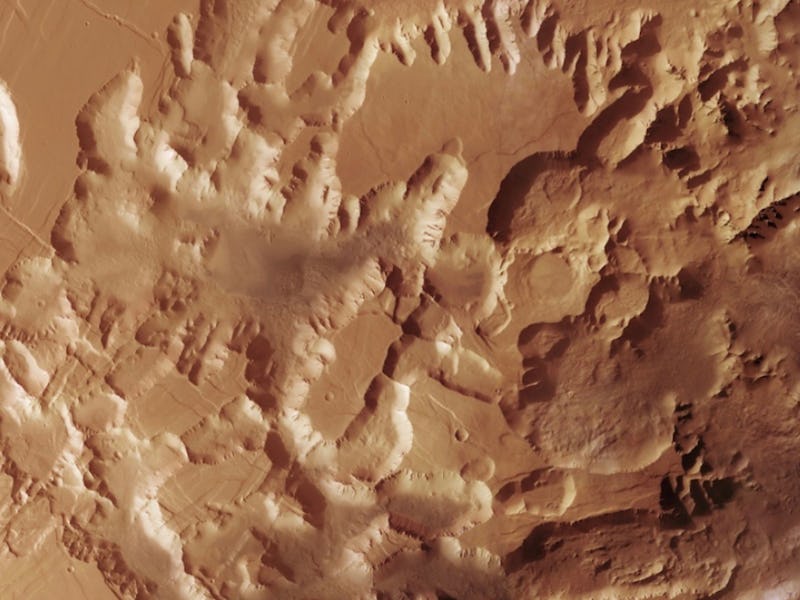This Could Be the Hot New Place to Look for Life on Mars
Noctis Mons has hidden in plain sight for decades, and it may be the perfect home for alien life.

The newest spot to search for life on Mars could be a collapsed volcano whose layers are sandwiched with the icy remains of ancient glaciers.
Noctis Mons (AKA the Night Mountain, which is an extremely cool name) has been hidden for a long time. Researchers just now recognized the jumbled terrain, in old images from decades of Martian satellites, as the remains of a collapsed volcano. It looks like Noctis Mons was active fairly recently (and it may still erupt again), and its slopes are layered with glacial ice and snow. That may make it the perfect place to search for alien life.
SETI Institute astrobiologist Pascal Lee and his colleagues presented their findings at the recent Lunar and Planetary Science Conference.
Looking down from orbit, Noctis Mons doesn’t immediately look like a volcano, but if you look closely, you can still spot the caldera at its center.
Fire, Ice, and Alien Life?
Lee and his colleagues recently realized that the strangle jumble of canyons and gently-sloping mesas in images of the Martian equator were actually the remains of a collapsed volcano, eroded and reshaped by glaciers. Looking closer, they spotted old lava flows, fields of pumice and ash, and minerals left by hydrothermal activity. And beneath the uppermost layer of volcanic debris lies a sheet of ice, which gleams here and there through an eroded hole in the thin blanket of volcanic ash that covers it.
Beneath the crumbling slopes of Noctis Mons, fire and ice may have created the perfect environment for life: warm, with plenty of liquid water and chemical nutrients. And since the volcano appears to have been active for a very long time, life has had plenty of opportunity to evolve from the complex chemistry that happens when water and volcanic rock meet.
All around the slopes of Noctis Mons lies a blanket of pumice and volcanic ash. Based on images from a whole series of Martian satellites, from Mariner 9 to the Mars Reconnaissance Orbiter, it’s between 3 and 9 feet thick, and it looks strangely blistered. Here on Earth, when hot volcanic ash lands atop ice, it cools quickly, but hot steam bubbled up beneath the surface, creating blister-like mounds. Where some of these mounds have eroded over time, satellite images reveal the telltale gleam of ice beneath a thin layer of minerals. Lee and his colleagues say the whole 1,900 square mile area of Noctis Mons could lie atop a huge ice sheet left over from one of the last glaciers to pass through the area.
That’s 1,900 square miles of ice interacting with the heat of a volcano, creating pockets and streams of liquid water underground, possibly for billions of years. In other words, it’s a huge Martian oasis that’s potentially perfect for life.
Noctis Mons is also an ideal place for rovers or — someday — astronauts to explore. Because it’s collapsed, what was once a tall, forbidding mountain is now “so deeply eroded that you could hike, drive, or fly through it,” says Lee in a recent statement. And all that glacial ice could support future exploration crews or provide the raw material for rocket fuel (assuming it’s not actually a sensitive alien habitat, that is).
In other words, the place is basically a theme park for astrobiologists.
A Volcano With a Messy Backstory
We don’t know how long ago Noctis Mons formed, but [authors] say it looks like the volcano has been active for a huge stretch of Martian history, and it’s been active fairly recently. It may even still be active today. Olympus Mons, the largest volcano in our Solar System, formed about 3.5 billion years ago and stayed active for millions of years, longer than any volcano here on Earth, but Noctis Mons may turn out to beat its neighbor’s impressive streak.
Noctis Mons was once a wide, gently-sloping mountain, built up over time from layers of lava and pyroclastic debris (small grains of volcanic ash and larger chunks of pumice). Between those layers of volcanic rock lay sheets of ice: some compacted snow that fell on the volcano’s slopes and some thick glaciers, all buried beneath the next eruption.
At some point, the magma welling up through cracks and fissures in the mountain melted all of that ice, causing the slopes of the volcano to collapse. Today, the summit is now just a partial ring of mesas, which slope gently downward. From above, it looks like a wide ring of broken rock, crossed by lava flows and cut by deep, glacier-carved canyons.
And someday it just might be the place where we discover we’re not alone in the Solar System.